

Pregnancy - Family Planning. Contraception - Family Planning. Syphilis - Family Planning. Syphilis is a sexually transmissible infection (STI).
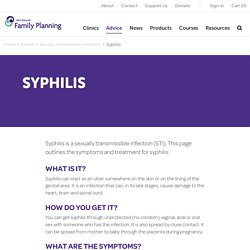
This page outlines the symptoms and treatment for syphilis. What is it? Syphilis can start as an ulcer somewhere on the skin or on the lining of the genital area. It is an infection that can, in its late stages, cause damage to the heart, brain and spinal cord. How do you get it? You can get syphilis through unprotected (no condom) vaginal, anal or oral sex with someone who has the infection. What are the symptoms? A painless ulcer, called a chancre, usually on the genitals. How is it treated? Syphilis is treated with antibiotics. Will this impact my partner/s? Genital Herpes - Family Planning. Genital herpes is a sexually transmissible infection (STI).

This page outlines the symptoms and the ongoing management of genital herpes. What is it? Genital herpes is an infection on the genitals caused by the herpes simplex virus. This is the same virus that causes cold sores around the mouth. How do you get it? Trichomoniasis - Family Planning. Non Specific Urethritis (NSU) - Family Planning. Genital Warts - Family Planning. Genital warts is a sexually transmissible infection (STI).
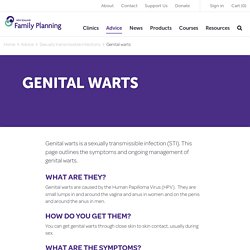
This page outlines the symptoms and ongoing management of genital warts. What are they? Genital warts are caused by the Human Papilloma Virus (HPV). They are small lumps in and around the vagina and anus in women and on the penis and around the anus in men. How do you get them? You can get genital warts through close skin to skin contact, usually during sex. What are the symptoms? Small lumps on the genitals. How is it treated? Obvious warts are treated, mainly for cosmetic reasons. A cream to rub on, which acts by helping the immune system fight the virus, ora liquid painted on the warts which kills the infected cells, orfreezing with liquid nitrogen, ordiathermy (heat).
Will this impact my partner/s? If partners have warts they should be treated. More information. Gonorrhoea - Family Planning. Gonorrhoea is a sexually transmissible infection (STI).
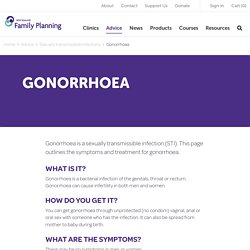
Chlamydia - Family Planning. Chlamydia is a sexually transmissible infection (STI).
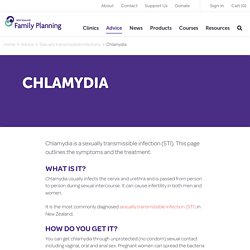
Genital herpes. Summary Most people with the genital herpes virus don't have symptoms and are unaware they have it.

It is a common infection. One in five New Zealanders are infected with HSV. There are 2 forms of the herpes simplex virus, HSV-1 and HSV-2. HSV-1 often causes cold sores around the mouth HSV-2 is the usual cause of infection around the genital or anal area. You can get genital herpes by having skin contact, vaginal, anal, or oral sex with someone who has either of the viruses. A mother can transmit the infection to her baby during childbirth if the mother has symptoms at the time. Once a person is infected with HSV, the virus remains in a person's body and may flare up again. Related websites Sexually transmitted infections – get help from Family Planning NZ Family Planning provides a range of services including sexual and reproductive health information and clinical services. Genital warts (HPV) Summary HPV is a very common sexually transmitted virus.

Most people are infected with HPV at some time in their life and have no symptoms. There are many types of HPV. Some high-risk types of HPV (types 16 and 18) may cause abnormal cell changes of the cervix (which can lead to cervical cancer years later), the anus, vulva, or throat in women. In men, these types can cause these changes in the penis, anus, or throat. Genital HPV is usually acquired by direct skin-on-skin contact with someone who has HPV during intimate sexual contact or by having vaginal, anal, or oral sex. In rare cases, the virus can be passed on to a baby when a woman with HPV gives birth. If you have the virus, but have no symptoms, you can still spread the virus through skin contact. Gonorrhoea. Summary Gonorrhoea is spread through skin contact during sex.

As well as genital gonorrhoea, you can also get gonorrhoea of the throat and anus by having anal and oral sex with someone who has the infection. One simple way to protect yourself from gonorrhoea is by using a condom when engaging in sexual intercourse. Related websites Sexually transmitted infections – Family Planning Family Planning provides a range of services including sexual and reproductive health information and clinical services. Gonorrhoea – Better Health Channel Information about gonorrhoea provided by the Victorian government, Australia. Gonorrhoea – NHS Choices Information about gonorrhoea from the National Health Service, UK. Chlamydia. Summary How is chlamydia spread?
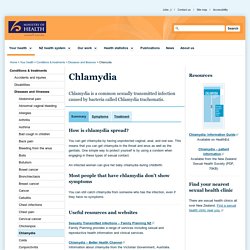
You can get chlamydia by having unprotected vaginal, anal, and oral sex. This means that you can get chlamydia in the throat and anus as well as the genitals. One simple way to protect yourself is by using a condom when engaging in these types of sexual contact. An infected woman can give her baby chlamydia during childbirth. Most people that have chlamydia don’t show symptoms You can still catch chlamydia from someone who has the infection, even if they have no symptoms. Useful resources and websites Sexually Transmitted Infections – Family Planning NZ Family Planning provides a range of services including sexual and reproductive health information and clinical services. Chlamydia – Better Health Channel Information about chlamydia from the Victorian Government, Australia. Chlamydia – NHS Choices Information about chlamydia from the National Health Service, UK.
Symptoms Most people that have chlamydia don't know it, since the disease often has no symptoms. Women.